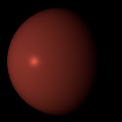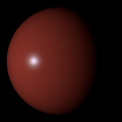Specular Constant for Anisotropic BSDF
When modeling anisotropic BSDF models, the measure does not allow you to make the difference between the diffuse /lambertian parts and the specular/gaussian parts. The model applies the color measured with the integrating sphere to the whole BRDF. The result is that the specular reflection is the same color as the diffuse part, which is often not the case in real situations. The specular constant model allows you to make the difference between the diffuse/lambertian parts and the specular/gaussian parts for anisotropic BSDF.
On the following example you can view a sphere with a colored reflection spectrum illumined by a white source.
Before, the specular highlight had the same spectrum as the diffuse part, both had the same color.

With the new model, the specular highlight is white and the diffuse part remains unchanged.



